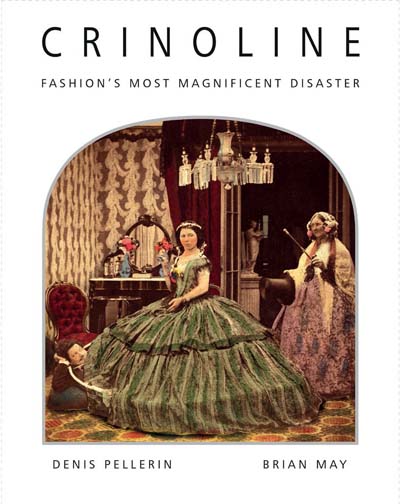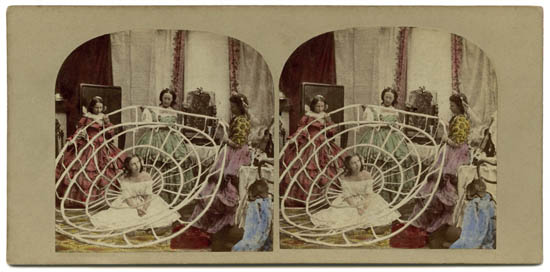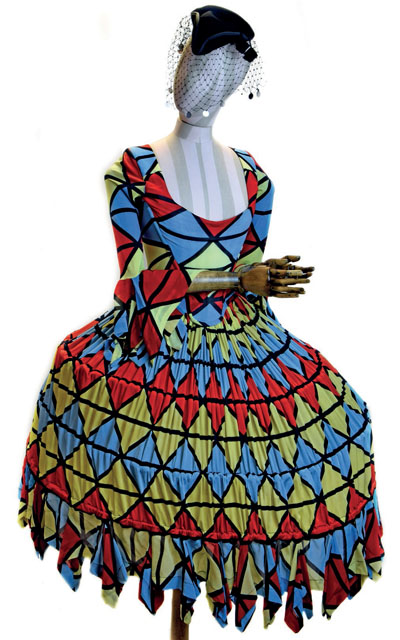

PRESS RELEASE:
A compelling, visually striking 3-D exploration of one of fashion’s most disastrous yet most celebrated garments, the Crinoline, featuring contributions from Vivienne Westwood and Zandra Rhodes – publishing to coincide with the V&A’s highly anticipated exhibition, Undressed: 350 Years of Underwear.
Crinoline: Fashion’s Most Magnificent Disaster, by Brian May & Denis Pellerin, published in hardback (with a slipcase and 3-D front cover, accompanied by Brian May’s patent 3-D viewer, the Owl) on 16th April 2016, £50, available to buy from all good bookstores and online
www.londonstereo.com and AMAZON HERE.
“A very special and wonderful book with enlightened research unveiling fascinating facts such as crinolines being considered an extremely dangerous form of clothing at one time. Great examples of 3-D pictures totally in keeping with its historical importance, complete with 3-D viewer.”
Dame Zandra Rhodes
“Crinolines and Stereoscopic photographs were twin sensations of the mid 19th century. We, the authors of this book, decided it was fitting that they should be reunited in the 21st century, and their intimate association recognised at last. This book explores the history of crinoline ‘in depth’. It’s also an attempt to fathom the unique appeal of this dangerous fashion, which, surprisingly, is alive and well in the present day, and its place in popular culture.”
Brian May & Denis Pellerin
The voluminous crinoline underskirt was immensely popular between the years of 1856 to 1867, but was by its very nature severely impractical: a strong gust of wind would blow the dress up exposing the woman’s legs and undergarments; worse still, the crinolines were cumbersome, caused accidents and proved to be a serious fire hazard. As the shapes of crinoline garments grew more and more extreme, artists were inspired to capture the absurdities and misfortunes of the wearers through stereo photos, as well as in cartoons and drawings. Just as Crinoline came into fashion, the stereoscope – the equivalent of TV and Film for the Victorians – became a huge craze. Stereo photographers capitalized on the ridiculous spectacle of the women in crinolines, giving impoverished Victorian husbands some consolation in laughter. Although the hoops and inflatable frames disappeared, this wonderful humorous imagery produced during the Crinoline decade has lasted intact over the centuries – and is rediscovered in this book.

The London Stereoscopic company, reborn in the 21st Century, explores “fashion’s most magnificent disaster” in the form of a delightful, lavish coffee table book, containing high quality reproductions of the original stereo images from the period. Brian May and Denis Pellerin have spent decades collecting and digitally restoring the stereo cards that are published here. Viewing the result through the supplied OWL stereoscope, readers will thrill to the magical three-dimensional realism of these scenes, just as the Victorians did.
Crinoline – the book – begins with the emergence of the steel petticoat and the initial onset of the “Crinoline Age”, and then takes the reader on a fascinating visual journey, including a wealth of colourful 3-D imagery, to the historical moment when women began to protest against the “cage” and it was eventually phased out. However, contemporary designers such as the late Alexander McQueen, Zandra Rhodes and Vivienne Westwood have reintroduced the crinoline to the catwalk, bringing the dramatic garment of the 19th century all the way into the 21st century with a modern twist.

A multicoloured harlequin Mini Crini and a corset.
Collection: Voyage to Cythera.
Season: Autumn/Winter 1989–90.
Dame Vivienne Westwood says:
“The crinoline idea had been with me for quite some time before I developed it into a collection. I wanted to save experimenting with the crinoline for a rainy day, so to speak…. The first time I ever saw a crinoline was in the ballet Petruschka and I was immediately drawn to it. The mini crinoline encourages you to walk with a certain swing and it swiggles, which I also like.” A
BOUT THE IMPRINT AND THE HISTORY OF THE LONDON STEREOSCOPIC COMPANY
Some time in 1854 ‘The London Stereoscope Company’ was born. Their business was selling stereo views and viewers to the public, and they were leaders in a boom – a craze which swept England, Europe, and eventually the United States too, of stereo photographs of every conceivable subject, which, viewed by means of a stereoscope, presented scenes in life-like three dimensions. In a world which had never experienced Television, the Movies, or the Internet, this was a major sensation. In February 1856, The London Stereoscopic Company (LSC) advertised, in the Photographic Journal, ‘The largest collection in Europe, upwards of 10,000’ stereo views.
BRIAN MAY’S introduction to stereoscopy was as a child, finding 3-D cards in his breakfast cereal. In the 1950s Weetabix gave away free coloured stereo cards in their packets, along with an opportunity to send off one-and-sixpence for the required stereoscope to view them with. Brian, discovering that he could free-view them without the viewer too, was entranced, and quickly figured out how to make his own stereo views, and was hooked for life. Scouring Portobello Road market for stereoscopic items some years later, Brian discovered the intriguing Diableries cards, which stirred a special passion which was to lead to the Diableries book 40 years later. While studying Astronomy at Imperial College, Brian became a regular viewer at Christie’s photographic auctions, at the time a rich source of hitherto unknown stereo views from the 1850s onwards. In 2008 Brian realised his dream of recreating The London Stereoscopic Company, its aim to bring the magic of true stereoscopy to the modern world. In order to share the magic of Victorian 3-D, Brian designed his own OWL stereoscope, which is now produced in large quantities. The OWL has become a new standard around the world in stereoscopic viewing. In 2011 Brian met a redoubtable French scholar, Denis Pellerin, one of theworld’s experts on French and English Photographic History. Their two passions connected immediately, and Denis became Brian’s curator, conservator, researcher, and co-author. The London Stereoscopic Company is now restoring and republishing Victorian classic cards, as well as original stereoscopic works relating to Astronomy and unseen, historic ‘Queen’ (the Rock Group) images.Finally the LSC completed the picture by entering into book publishing, each new work accompanied by an OWL Stereoscope included in the package. The first three titles are A Village Lost and Found (based on a celebrated series by TR Williams made around 1853), Diableries (the entire genre of 1860s French Devilments brought together for the first time), and The Poor Man’s Picture Gallery (stereo views of famous paintings in the Tate Gallery).
The London Stereoscopic Company is the ONLY publisher in the world dedicated exclusively to publishing stereoscopic works. Our mission is to share the world’s greatest 3-D images, from Victorian times to the present day.
BRIAN MAY’S OWL: Brian has created the definitive high-quality modern-day stereoscope; reminiscent of an Owl, he named it just that. Every book the LSC publishes comes with an Owl, and the illustrations in the book, reproduced by the highest resolution printing technology available will, through this device, delight you all just as they did in Victorian times. –
—
NOTE: Brian May has loaned a selection of the stereo photographs that feature in the book to the V&A for the forthcoming exhibition, Undressed: A Brief History of Underwear (16 April 2016 – 12 March 2017). www.londonstereo.com